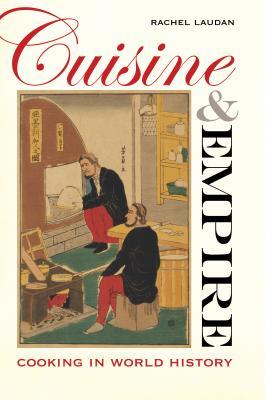Cuisine and Empire: Cooking in World History
- By Rachel Laudan
- University of California Press
- 488 pp.
- Reviewed by Ann White
- November 21, 2013
An in-depth look at sustenance through the centuries.

In Cuisine and Empire, Rachel Laudan chastises chef Emeril Lagasse for telling his television viewers that cooking isn’t rocket science. For Laudan, cooking transcends the question of whether to sauté the chicken or roast it: “Chinese noodles and soy sauce, Roman sauces and raised bread, Islamic distillation, Western cakes and chocolate are technological achievements that stand alongside Chinese bronzes, Roman hydraulic engineering, Islamic ceramics, and Western steam engines.” Even though Lagasse considers using cooking techniques easy, Laudan, in this historical study, reminds readers that “developing them in the first place was rocket science.”
Cuisine and Empire offers a global history of food and the way human beings have cooked it. Beginning with “Mastering Grain Cookery, 20,000-300 B.C.E.” (Chapter 1) and ending with “Modern Cuisines: The Globalization of Middling Cuisines, 1920-2000” (Chapter 8), Laudan aims for breadth of chronology and depth of analysis.
The “middling cuisines” of the 20th century began to develop in the years after 1650, with the Dutch and the British pioneering the idea of government by consent of the governed. As more and more nations located political power in the will of the people, Laudan points out that “it became increasingly difficult to deny to all citizens the right to eat the same kind of food.” Eaters of middling cuisines could enjoy taste-enhancing sauces and sweets, plus more fats, sugar and processed foods than eaters of “traditional humble cuisines.”
During the Industrial Revolution, middling cuisines expanded from the bourgeoisie to the salaried middle classes and the urban working classes. Beef — or beef extract — and white bread fed the people of 19th-century England. For many years, historians, nutritionists and economists (including present-day economist Paul Krugman) condemned this English cuisine for its poor taste and poor nutrition. Laudan, however, disagrees. She cites research showing that the nutrition of the working class poor improved during the Industrial Revolution. Moreover, she has no patience with snobbery about white bread. According to Laudan, bread was warm, comforting and easy to carry into mines and factories, and white bread was more digestible and better-tasting than whole-meal bread.
Refreshingly, Laudan rejects all food snobbery, including the current farm-to-table, everything-from-scratch foodie ethos. She deplores society’s habit of romanticizing home-cooked food as superior to industrially processed food. Ought a reader to shudder at the mention of “processed foods” in Laudan’s description of middling cuisines? Absolutely not. Laudan’s historical perspective shows how food processing bestowed huge gifts on the development of cuisines. Cuisine and Empire allows readers to recognize “how the large-scale, efficient bakeries and fish sauce manufacturies in Rome, tea-processing facilities in Buddhist monasteries, herring-packing plants in Holland, sugar beet refineries in France, and roller mills around the world have improved diets, reduced heavy manual labor, and enhanced the range of tasty foods.”
An academic work with a bibliography of 800-plus items, Cuisine and Empire presents the reader with a dense array of facts. Not only are the facts dense on the page but also their relationship to each other sometimes remains unclear. For example, in Laudan’s writing, the Christian religious act of the Eucharist also becomes a “Christian cuisine.”
Cuisine and Empire’s academic density does not, however, prevent its author’s passionate arguments and engaging personal observations, such as Laudan’s discussion of mastering grain cookery, from shining through. After listing the culinary advantages of grains, she points out a big disadvantage: Grains must be ground if they are to be turned into bread. Her farmer father experimented with turning some of his wheat into flour by hand, first with mortar and pestle, then with a mincer and then with a hammer. All of these tools failed. Despite having sacks full of wheat in their barns, Laudan says, her family might have starved without commercial millers.
For even more personal experience, Laudan received a grinding lesson from a friend in Mexico, learning firsthand about the hard labor still practiced by women in remote Mexican villages: They must grind five hours every day to prepare maize to feed a family of five or six.
The graceful writing of the personal observations in Cuisine and Empire may cause readers to hope that Rachel Laudan will write a shorter, less formal book summarizing the history that supports her arguments, especially her argument that everyone in the world should be able to enjoy a middling cuisine. She concludes the book by describing Mexican mothers and grandmothers shopping in her Mexico City grocery store. She exults in the huge variety of food available to them — foods for those with time to cook, for those who don’t want to cook, in all price ranges and from all parts of the world. Laudan notes that, not too long ago, many of these women would have been grinding for hours every day. Now, industrialized food processing has brought them what Laudan wishes for everyone — “the choice, the responsibility, the dignity, and the pleasure of a middling cuisine.”
Ann White is the retired chairwoman of the history department of Edmund Burke School in Washington, DC. She holds a Ph.D. in Far Eastern history from the University of Pennsylvania.

